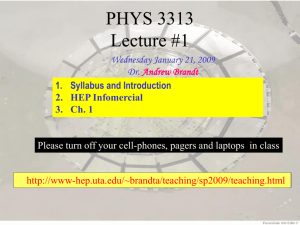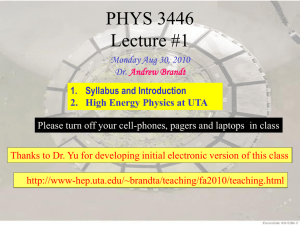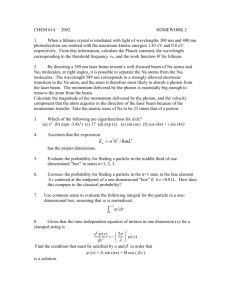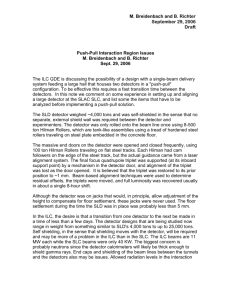phys3446-lec1
advertisement
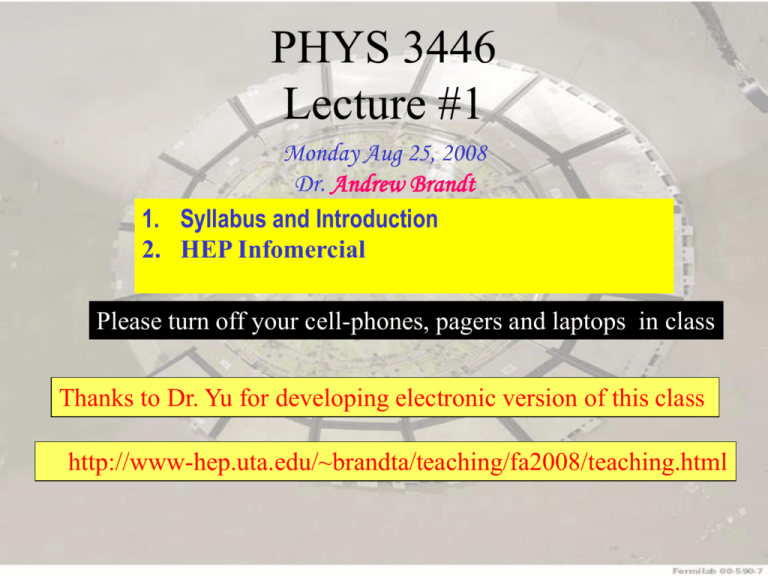
PHYS 3446 Lecture #1 Monday Aug 25, 2008 Dr. Andrew Brandt 1. Syllabus and Introduction 2. HEP Infomercial Please turn off your cell-phones, pagers and laptops in class Thanks to Dr. Yu for developing electronic version of this class http://www-hep.uta.edu/~brandta/teaching/fa2008/teaching.html Course Material • Nuclear Physics – Models of atom – Cross sections – Radiation • High Energy Experimental Techniques – Energy deposition in matter – Particle detector techniques and detectors – Accelerators • HEP Phenomenology – – – – Elementary particle interactions Symmetries The Standard Model Beyond the Standard Model Attendance and Class Style • Attendance: – is STRONGLY encouraged, to aid your motivation I give pop quizzes • Class style: – Lectures will be primarily on electronic media • The lecture notes will be posted AFTER each class – Will be mixed with traditional methods (blackboard) – Active participation through questions and discussion are STRONGLY encouraged Grading • Midterms: 40% – – – – • • • • 2 Tests 20% each (Oct. 13, Nov. 24) No Final Exams will be curved if necessary No makeup tests Homework: 20% (No late homework) Lab score: 20% (More about lab on Weds.) Pop Quizzes: 10% Project: 10% (report on significant result in nuclear/particle physics) High Energy Physics at UTA UTA faculty Andrew Brandt, Kaushik De, Amir Farbin, Andrew White, Jae Yu along with many post-docs, graduate and undergraduate students investigate the basic forces of nature through particle physics studies at the world’s highest energy accelerators In the background is a photo of a sub-detector of the 5000 ton DØ detector. This sub-detector was designed and built at UTA and is currently operating at Fermi National Accelerator Laboratory near Chicago. Structure of Matter Matter Molecule Atom Nucleus Baryon Quark (Hadron) u cm 10-14m 10-9m 10-10m Nano-Science/Chemistry Atomic Physics Nuclear Physics 10-15m <10-19m top protons, neutrons, , bottom, mesons, etc. charm, strange, p,W,L... up, down Electron (Lepton) <10-18m High energy means small distances High Energy Physics Helium Periodic Table Neon All atoms are made of protons, neutrons and electrons u u d u d d Neutron Proton Gluons hold quarks together Photons hold atoms together Electron What is High Energy Physics? Matter/Forces at the most fundamental level. Great progress! The “STANDARD MODEL” BUT… many mysteries => Why so many quarks/leptons?? => Why four forces?? Unification? => Where does mass come from?? => Are there higher symmetries?? What is the “dark matter”?? Will the LHC create a black hole that destroys the Earth? NO! See: http://public.web.cern.ch/Public/en/LHC/Safety-en.html Role of Particle Accelerators • Smash particles together • Act as microscopes and time machines – The higher the energy, the smaller object to be seen – Particles that only existed at a time just after the Big Bang can be made • Two method of accelerator based experiments: – Collider Experiments: p`p, pp, e+e-, ep – Fixed Target Experiments: Particles on a target – Type of accelerator depends on research goals Fermilab Tevatron and CERN LHC • Currently Highest Energy proton-anti-proton collider – Ecm=1.96 TeV (=6.3x10-7J/p 13M Joules on 10-4m2) Equivalent to the K.E. of a 20 ton truck at a speed 81 mi/hr Highest Energy protonproton collider in fall 2008 – Ecm=14 TeV (=44x10-7J/p 1000M Joules on 10-4m2) Equivalent to the K.E. of a 20 ton truck at a speed 711 mi/hr Chicago 1500 physicists 130 institutions 30 countries CDF • p Tevatron DØ `p Fermilab: http://www.fnal.gov/ ; DØ: http://www-d0.fnal.gov/ 5000 physicists 250 institutions 60 countries CERN: http://www.cern.ch/ ; ATLAS: http://atlas.web.cern.ch/ The International Linear Collider European Design 500 GeV (800 GeV) • Long~ linear electron-position colliders 33km= • Optimistically 15 47 km 21mi years from now • Takes 10 years to =29 mi build an accelerator and the detectors US Design 500 GeV (1 TeV) Particle Identification Energy Scintillating Fiber Silicon Tracking Calorimeter (dense) Interaction Point Ä B EM Muon Tracks Magnet Charged Particle Tracks hadronic electron photon Wire Chambers jet neutrino -- or any non-interacting particle missing transverse momentum We know x,y starting momenta is zero, but along the z axis it is not, so many of our measurements are in the xy plane, or transverse muon DØ Detector ATLAS Detector 30’ 50’ • • • • • • Weighs 5000 tons As tall as a 5 story building Can inspect 3,000,000 collisions/second Record 100 collisions/second Records 10 Mega-bytes/second Recording 0.5x1015 (500,000,000,000,000) bytes per year (0.5 PetaBytes). • • • • • • Weighs 10,000 tons As tall as a 10 story building Can inspect 1,000,000,000 collisions/second Will record 200 collisions/second Records 300 Mega-bytes/second Will record 2.0x1015 (2,000,000,000,000,000) bytes each year (2 PetaByte). The Standard Model Standard Model has been very successful but has too many parameters, does not explain origin of mass. Continue to probe and attempt to extend model. The strong force is different from E+M and gravity! new property, color charge confinement - not usual 1/r2 • Current list of elementary (i.e. indivisible) particles • Antiparticles have opposite charge, same mass UTA and Particle Physics Fermilab/Chicago CERN/Geneva Building Detectors at UTA High Energy Physics Training + Jobs EXPERIENCE: 1) Problem solving 2) Data analysis 3) Detector construction 4) State-of-the-art high speed electronics 5) Computing (C++, Python, Linux, etc.) 6) Presentation 7) Travel JOBS: 1) Post-docs/faculty positions 2) High-tech industry 3) Computer programming and development 4) Financial My Main Research Interests • Physics with Forward Proton Detectors • Fast timing detectors • Triggering (selecting the events to write to tape): at ATLAS 200/40,000,000 events/sec DØ Forward Proton Detector (FPD) - a series of momentum spectrometers that make use of accelerator magnets in conjunction with position detectors along the beam line • Dipole Spectrometer • inside the beam ring in the horizontal plane • use dipole magnet (bends beam) • Quadrupole Spectrometers • surround the beam: up, down, in, out • use quadrupole magnets (focus beam) • also shown here: separators (bring beams together for collisions) A total of 9 spectrometers comprised of 18 Roman Pots Data taking finished, analysis in progress (Mike Strang Ph.D.) Detector Construction At the University of Texas, Arlington (UTA), scintillating and optical fibers were spliced and inserted into the detector frames. The cartridge bottom containing the detector is installed in the Roman pot and then the cartridge top with PMT’s is attached. Tevatron: World’s Highest Energy Collider Fermilab DØ High-tech fan One of the DØ Forward Proton Detectors built at UTA and installed in the Tevatron tunnel FP420 Overview FP420: Particle physics R&D collaboration that proposes to use double proton tagging at 420m as a means to discover new physics NEW Central Exclusive Higgs Production pp p H p : 3-10 fb E.g. V. Khoze et al M. Boonekamp et al. B. Cox et al. V. Petrov et al… Levin et al… b -jet gap p gap H p b -jet beam h Idea: Measure the Missing mass from the protons M H2 ( p p p' p' )2 dipole M = O(1.0 - 2.0) GeV dipole p’ roman pots roman pots p’ Arnab Pal Cerenkov Effect n=1 n>>1 particle Use this property of prompt radiation to develop a fast timing counter Fast Timing Detectors for ATLAS WHO? WHY? UTA (Brandt), Alberta, Louvain, FNAL Background Rejection Ex, Two protons from one interaction and two b-jets from another proton Use timing to measure vertex and compare to central tracking vertex How? How Fast? 10 picoseconds (light travels 3mm in 10 psec!) Pedro Duarte (M.S.) Shane Spivey Ian Howley Fused Silica Bars • 9 cm bars • Some converted to mini-bars Simulation by Joaquin Noyola (UG) other studies by UG Chance Harenza+ Alek Malcolm 60 psec Spread in timing as f() since n() MCP-PMT Operation photon Faceplate Photocathode Photoelectron Dual MCP V ~ 2000V Gain ~ 106 Anode V ~ 200V V ~ 200V Test Beam • Fermilab Test beam T958 experiment to study fast timing counters for FP420 (Brandt spokesman) • Used prototype detector to test concept • Test beam at Fermilab Sep. 2006, Mar.+Jul. 2007 • CERN October 2007, June 2008 Time resolution for the full detector system: 1. Intrinsec detector time resolution 2. Jitter in PMT's 3. Electronics (AMP/CFD/TDC) Latest QUARTIC Prototype Testing long bars 90 cm, more light than 15 mm mini-bars (due to losses in air light-guide) but more time dispersion due to n() FP420 Timing Setup Data Acquisition • Lecroy 8620A 6 GHz 20 Gs • Lecroy 7300A 3 GHz 20/10 Gs • Remotely operated from control room • Transfer data periodically with external USB drive Good Event 5 ns/major division Online Screen Capture one histo is 10 ps per bin others are 20 ps delta time between channels QUARTIC Long Bar Resolution Dt 56.6/1.4=40 ps/bar including CFD! Undergraduate Student Research Opportunities Several aspects of fast timing project are short of (wo)manpower: 1) 2) 3) 4) 5) Helping to setup and operate laser test stand Operating/improving ray tracing simulation Commercial ray tracing program to aid in simulation HEP detector simulation GEANT4 Test beam data analysis Experience with C++ required for some but not all of the projects Some funding available (results oriented) Laser Test Stand Argonne National Lab setup Use Hamamatsu picosecond laser to measure timing of PMT, electronics QUARTIC Bar Length Studies 15mm bar/75 mm lightguide 20 ps 90mm bar 40 ps 40 ps Summary • If you are here to learn about Nuclear/Particle Physics this should be an interesting and fun class, if you are here because you need four hours of physics…. a) get out while you still can OR b) it will still be an interesting and fun class (up to you) • It is an opportunity to learn about high energy physics from a high energy physicist • Lab takes time, there will be reading outside of main text • See me if interested in UG research project
